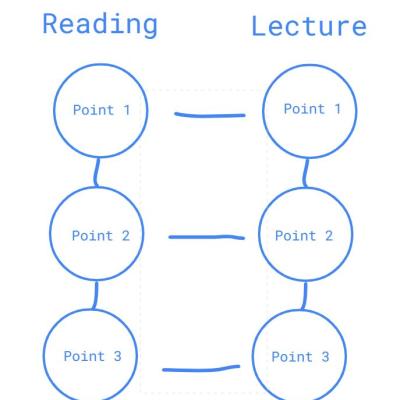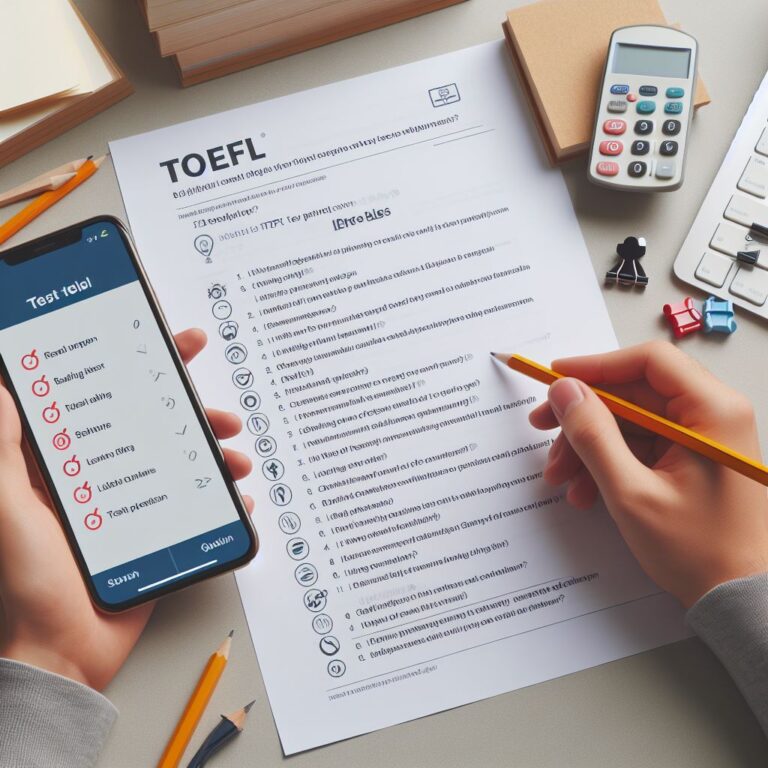TOEFL Writing Question 1: The Integrated Task

Key Takeaways
To ace the TOEFL writing Question 1 make sure to do the following:
- Listen to the audio and take notes
- Read the passage and take note of the important information
- Connect the notes you took from the audio and the passage
- Write a summary
- Edit
What you will find in this guide:
TOEFL Writing Question 1
The TOEFL Writing Question 1, the integrated task, is the first task in the TOEFL Writing section, and it’s a crucial one that tests your ability to summarize, paraphrase, and report on complex academic topics1. Question 1 is unique in its format. Unlike the Writing for Academic Discussion task where you express your own opinion, the Integrated Writing task requires you to summarize opinions that you read and hear1. This task is all about your note-taking, paraphrasing, and reporting skills1.
The TOEFL Integrated Writing Task will present you with a passage that is about 250-300 words long1. You’ll then listen to a lecture that lasts 2 to 2.5 minutes1. The lecture will challenge or disagree with the ideas in the reading passage1. This means you’ll need to be adept at understanding both written and spoken English, and be able to synthesize this information effectively.
The question will ask you to summarize the points made in the lecture, and explain how they oppose specific points in the reading passage2. You’ll have 20 minutes to write a 150-225 word summary2. It’s a challenging task, but with the right preparation and practice, you can excel at it.
Now, let’s take a look at a sample question to see what the task looks like what it wants you to do.
Sample Question 1
The Reading
In 1939, David O Selznick produced a film of Margaret Mitchell’s Pulitzer Prize winning novel, Gone with the Wind. The movie proved to be among the most important in the history of world cinema. To this day, in fact, it remains the American box office champion when adjusted for inflation. In 1940, the film won a record-breaking eight Academy Awards, including Best Picture. Recently, however, Gone with the Wind has increasingly come under fire due to allegations of racism in the movie. Consequently, its reputation has fallen in many critical circles.
The film tells the story of a Southern family who fight on the side of the Confederacy in the American Civil War. Scarlett O’Hara, the main character, is a slave owner whose civilization goes to war to preserve the right to own and degrade African Americans. Life before the Civil War, during the days of slavery, is depicted as a golden age.
Scarlett’s maid and confidante, Mammy, is not even given a first name in the script. Meanwhile, Butterfly McQueen, who portrayed Prissy, a house servant whom Scarlett slaps across the face at one point in the film, was told by the director to deliver a hysterical performance emphasizing the character’s dim-wittedness, speaking to age-old negative stereotypes. Civil rights activist Malcolm X wrote of his embarrassment seeing Butterfly McQueen’s performance as Prissy that it made him want to crawl under the rug of the theater.
For all of these reasons, when watching Gone with the Wind today, modern viewers cannot help but feel admiration for how far the movie industry has come since its infancy. There is much to be embarrassed about in the early days of Hollywood films.
The Audio
The Question
How does the listening passage relate to the information in the reading passage?
Take 20 minutes to write a response to the above question.

Guide to Question 1
Here is my step-by-step guide on how to ace TOEFL writing question 1, the integrated task:
Step 1: Read the passage
Before you start writing, read the passage carefully to get a good understanding of the author’s main argument, supporting details, and examples. Take note of key points and important details. Make sure you understand the author’s point of view and the purpose of the passage. Make sure to take notes as you read to help you remember key ideas and examples.
Step 2: Listen to the audio and take notes
Listen to the audio file carefully and take notes on the speaker’s main arguments, supporting details, and examples. Pay attention to how the lecture contradicts the passage. Try to identify the speaker’s main point of view, the purpose of the speech, and any new information presented. Make sure you take notes that will help you connect the passage with the audio.
Step 3: Use your notes
Make sure to identify the relationship. Once you have taken notes on the passage and the audio, use them to find connections and relationships between the two sources. Identify the differences and any contradictions. Look for examples from both the passage and the audio that support your arguments. Your goal is to show how the two sources connect and how they contribute to the overall argument.
Step 4: Make an outline
With your notes and connections in mind, create an outline for your essay. Decide on the structure of your essay and the order in which you will present your ideas. Start with an introduction and introduce the topic. State the main points clearly, each in one paragraph. Decide on appropriate language to explain the main ideas each paragraph will cover. You do not need a conclusion.
Step 5: Write your essay
Make sure your sentences are clear and concise. Use topic sentences to introduce each paragraph and provide evidence to support your arguments. Use transitional phrases and linking words to connect your ideas and create coherence.
Step 6: Edit
Once you have finished writing, revise your essay. Check your grammar, spelling, and punctuation carefully. Make sure your sentences are accurate and clear. Use transitions and linking words to create coherence and flow between paragraphs. Use a range of vocabulary and sentence structures to express your ideas effectively. Finally, proofread your essay carefully to catch any errors or typos.
Important Tips
Tip 1: Focus on your notes
This is the most important part of the integrated essay. You have to take notes while reading the passage and listening to the lecture. You cannot go back to them later, so you have to capture the main points and details as accurately as possible. You can use abbreviations, symbols, or diagrams to save time and space. You can also use different colors or formats to distinguish between the passage and the lecture.
Make sure to connect the ideas in your notes and identify the relationship between the passage and the lecture in your notes. The integrated essay is not just a summary of two sources. You have to show how they are connected and how they support or contradict each other. There are four common types of relationships: agreement, disagreement, partial agreement, or extension. You can use signal words or phrases to indicate the type of relationship, such as “according to”, “however”, “in contrast”, or “in addition”.
To do this, I recommend taking notes like this:

Tip 2: focus on the lecture
The lecture summary is the most important part of the essay. Shorten the reading summary if you need to save time. The integrated essay is not a summary of the reading passage. It is a summary of the lecture, with references to how it relates to the reading passage. Therefore, you should spend more time and words on summarizing the lecture than on summarizing the reading. A good rule of thumb is to write one paragraph for the reading summary and two paragraphs for the lecture summary.
Tip 3: Write adequately
I recommend between 220 to 280 words. The TOEFL integrated essay has a word limit of 300 words. Writing too little can lower your score, as it may indicate that you did not understand the sources or that you did not have enough language skills to express yourself.
Tip 4: Use transitional phrases
Use transitional phrases like “in contrast” and “moreover” and “finally” just like I did. Transitional phrases are words or phrases that help you connect your ideas and show how they are related. They can also help you organize your essay and make it easier for the reader to follow your logic. For example, you can use transitional phrases like “in contrast” or “however” to show a contrast between the reading and the lecture, or “moreover” or “in addition” to show an agreement or a similarity. You can also use transitional phrases like “first”, “second”, “third”, or “finally” to indicate the order of your points.
Tip 5: Always cite the source
Always be sure to indicate where the details are from (the reading or the lecture). One of the main skills that the TOEFL integrated essay tests is your ability to synthesize information from different sources. This means that you have to show that you can combine and compare the information from the reading and the lecture in a coherent way. To do this, you have to make it clear where each detail or example comes from, whether it is from the reading or the lecture. You can use phrases like “according to the reading”, “the lecturer states”, “the reading claims”, or “the lecturer explains” to introduce each source.
Tip 6: Paraphrase
Avoid copying from the reading word for word. Paraphrase as much as you can. Another skill that the TOEFL integrated essay tests is your ability to paraphrase information from the sources. Paraphrasing means expressing the same idea in different words, without changing its meaning. Paraphrasing shows that you understand the sources and that you can use your own words to convey their message. Copying from the reading word for word is not a good strategy, as it may lower your score for language use and plagiarism. You should try to paraphrase as much as possible, using synonyms, changing word order, or changing grammatical structures.
Tip 7: Focus on accuracy
Focus on accuracy. You don’t need fancy grammatical structures. The accuracy of your details is more important in this task. The TOEFL integrated essay is not a test of your creativity or your style. It is a test of your comprehension and your reporting skills. Therefore, you don’t need to use fancy grammatical structures or complex vocabulary to impress the reader. What matters more is that you can accurately report the main points and details from the sources, without making mistakes or omitting important information. You should focus on writing clear and simple sentences that convey the meaning of the sources correctly.
Tip 8: Practice with a Template!
Practicing with templates can help you improve your score in writing integrated task in the TOEFL exam. But remember that this is just a template to give your writing structure. Please do not use the exact order and the exact words in this template. You are not supposed to use memorized phrases because using memorized phrases will bring your writing score down.
Writing Template
Read the template below or check out my other question 1 templates here.
Introduction:
Both the reading and lecture address _____. The author of the article makes the case that _____, but the lecturer disputes this and argues instead that _____.
Body Paragraphs:
According to the reading, _____. The article asserts that _____. This viewpoint is challenged by the lecturer, who claims that _____. He also points out that _____.
In addition, the author suggests that _____. The article indicates that _____. However, the lecturer maintains that _____. He further argues that _____.
Lastly, the author advances the notion that _____. The article argues that _____. In opposition to this, the lecturer’s stance is that _____. He reasons that _____.
Conclusion: Not necessary.
Practice Writing
Ready to tackle the TOEFL Writing Question 1? Use the comprehensive guide you read on this page to write an answer to the following writing practice test in an impressive essay!
TOEFL Writing Question 1
The Article
Sea otters are a small mammal that lives in the waters along North America’s west coast from California to Alaska. A few years ago some of the sea otter populations off of the Alaskan coast started to decline rapidly and raised several concerns because of their important role in the coastal ecosystem. Experts began investigating and came up with two possible explanations. One explanation was environmental pollution and the second was attacks by predators.
At first it seemed as if the pollution was the most likely cause for the population decline. One reason pollution was more likely was because of the known pollution sources along the Alaskan coast such as oil rigs. Also water samples taken in the area showed increased levels of chemicals that could decrease the otters’ immune systems and indirectly result in their deaths.
Another thing that pointed to pollution as the culprit was the decline of other sea mammals such as seals in the same areas. This indicated that whatever was affecting the otters was also affecting the other sea mammals. Environmental pollution usually affects an entire ecosystem instead of just one species. Only predators that occurred in a large area, such as orcas (a large predatory whale), could cause the same effect, but they usually hunt larger prey.
Finally, scientists believed the pollution hypothesis would also explain the uneven pattern of otter decline. In some Alaskan locations the otter population declined greatly while other populations remained stable. Some experts suggested this could be explained by ocean currents, or other environmental factor, might have created uneven concentrations of pollutants along the coast.
The Lecture
The Question
Summarize the point made in the lecture and explain how the speaker cast doubt on specific points made in the reading passage.







The article and the lecture are both about the possibility of colonizing asteroids. While the paper presents that this idea can have advantages in science, economy, and the long-term survival of human beings; the speaker states that these factors are unrealistic and unpredictable because humans have insufficient knowledge about asteroids, the minerals they contain, and the conditions of their surfaces.
One important point mentioned by the article is that asteroids are advantageous for scientific research because they have fascinating characteristics such as their length, low gravity, and atmosphere. In addition, the author believes that if the investigation initiates now, it can direct us to long distant missions and thus to discoveries. However, the lecturer claims that it is impossible to ensure that this will be beneficial to science with the scant knowledge about asteroids we have. Furthermore, the speaker argues that humans do not know how many asteroids are there and if they are all explorable.
The second point that was discussed was the economic benefits of exploring asteroids. The article notes that mining asteroids would be productive and convenient since they possess many natural resources that we use. Moreover, the reading states that mining in space might stop the mining on our planet. In contrast, the lecturer’s stance is that all these resources are undetermined and we do not know how many are there nor their cost when transported back to earth.
Finally, the author mentions the future communities of humans would be stable on asteroids which may save the human race in the long run if the earth goes through a war or a natural disaster. Nevertheless, the lecture points out that humans would not be able to carry out the challenges of gravity that the asteroids have since this can affect their way of living, health, and economy.
The article and the lecture are both about the possibility of colonizing asteroids. While the article presents that this idea can have advantages in science, economics, and the long-term survival of the human race; the speaker states that these factors are not realistic or feasible since there is a lack of knowledge, an incalculable amount of minerals, and a hard environment.
One important point mentioned by the article is that asteroids are advantageous for scientific research because they have the same fascinating characteristics such as they are not large, with no gravity or atmosphere. In addition, the author believes that if the investigation initiates now, it can direct us to long distant missions and thus to new discoveries. However, the lecturer claims that is impossible to ensure that this will be beneficial to science with the scant knowledge about asteroids we have. Furthermore, the speaker argues that humans do not really know how many asteroids are there and if they are all explorable and we cannot assume we will have benefits by colonizing the asteroids.
According to the reading, there are also economic benefits to exploring the asteroids. The article notes that mining asteroids are productive and convenient since they possess many natural resources that we need. Also, the reading states that by doing this we can avoid mining our planet. In contrast, the lecturer’s stance is that all these sources are undetermined and we do not know how many are there as well as their cost at the moment of transporting them to the earth.
As the last point, the author mentions the future communities the humans can stable on asteroids which can save the human race in the long run if the earth goes through a war or a natural disaster. Nevertheless, the lecture points out that humans would not be able to carry out the challenges of gravity that the asteroids have since this can affect the way the live.